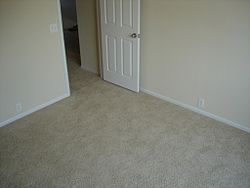- Baseboard
-
For other uses, see Baseboard (disambiguation).
In architecture, a baseboard (also called skirting board, skirting, mopboard, floor molding, as well as base molding) is a (generally wooden) board covering the lowest part of an interior wall. Its purpose is to cover the joint between the wall surface (usually plaster or drywall) and the floor.
It covers the uneven edge of flooring next to the wall; protects the wall from kicks, abrasion, and furniture; and can serve as a decorative molding.
At its simplest, baseboard consists of a simple plank nailed, screwed or glued to the wall; however, particularly in older houses, it can be made up of a number of mouldings for decoration.
Plastic baseboard is usually available in white or a flexible version in several colors and is generally glued to the wall. Wooden baseboard is available in paint or stain grade versions. Paint grade will not take stain well. Paint grade baseboards can be either "raw finger jointed" or "primed." Stain grade woods—such as oak, pine, and maple—are clearer and are suitable for staining in natural finishes.
Radiators are sometimes installed inside or in front of baseboards (baseboard radiators).
A baseboard differs from a wainscot; a wainscot typically covers from the floor to around 1-1.5m high (waist or chest height), whereas a baseboard is typically only 0.2m high (ankle height).
See also
Categories:- Woodworking
- Floors
- Walls
- Residential heating
Wikimedia Foundation. 2010.

